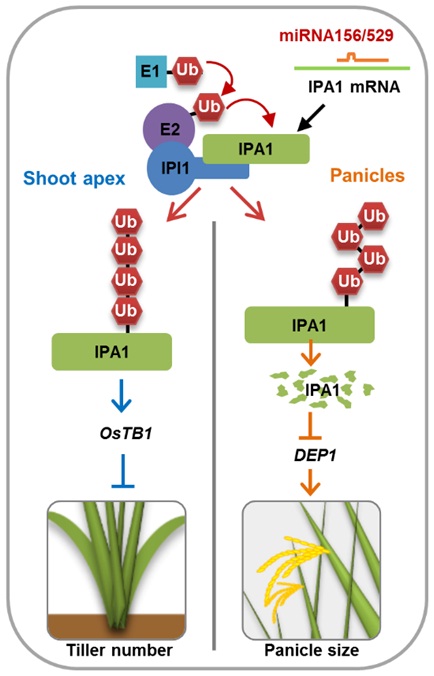Rice plant architecture is one of the major factors that determine rice yield. Shaping ideal plant architecture is one efficient way in breeding high yield elite rice varieties. Previously study reveals that IPA1 (Ideal Plant Architecture 1) functions as a SBP-box transcription factor that regulates multiple processes in rice development.
Recently, a research team led by Prof. LI Jiayang in the Institute of Genetics and Developmental Biology, Chinese Academy of Sciences has identified a RING-finger E3 ligase, IPI1, which could interact with IPA1 in the nucleus and ubiquitinate IPA1.
The ipi1 loss-of-function mutants showed markedly altered plant architecture, including more tillers, enlarged panicles, and increased yield per plant. Further study show that IPI1 could promote the degradation of IPA1 in panicles while it stabilizes IPA1 in shoot apexes.
These results provide a new insight into the tissue-specific regulation of plant architecture and important genetic resources for molecular breeding applications.
This work entitled "Tissue-specific Ubiquitination by IPA1 INTERACTING PROTEIN 1 Modulates IPA1 Protein Levels to Regulate Plant Architecture in Rice" was published in
Plant Cell (
doi:10.1105/tpc.16.00879).
The research was supported by the National Key Research and Development Program of China, National Natural Science Foundation of China and the Chinese Academy of Sciences.
 |
|
A Proposed Model of IPI1 Mediated Post-Translational Modification of IPA1. (Image by IGDB) |
CONTACT:
LI Jiayang
E-mail: jyli@genetics.ac.cn
 A Proposed Model of IPI1 Mediated Post-Translational Modification of IPA1. (Image by IGDB)CONTACT:
A Proposed Model of IPI1 Mediated Post-Translational Modification of IPA1. (Image by IGDB)CONTACT: CAS
CAS
 中文
中文




.png)
